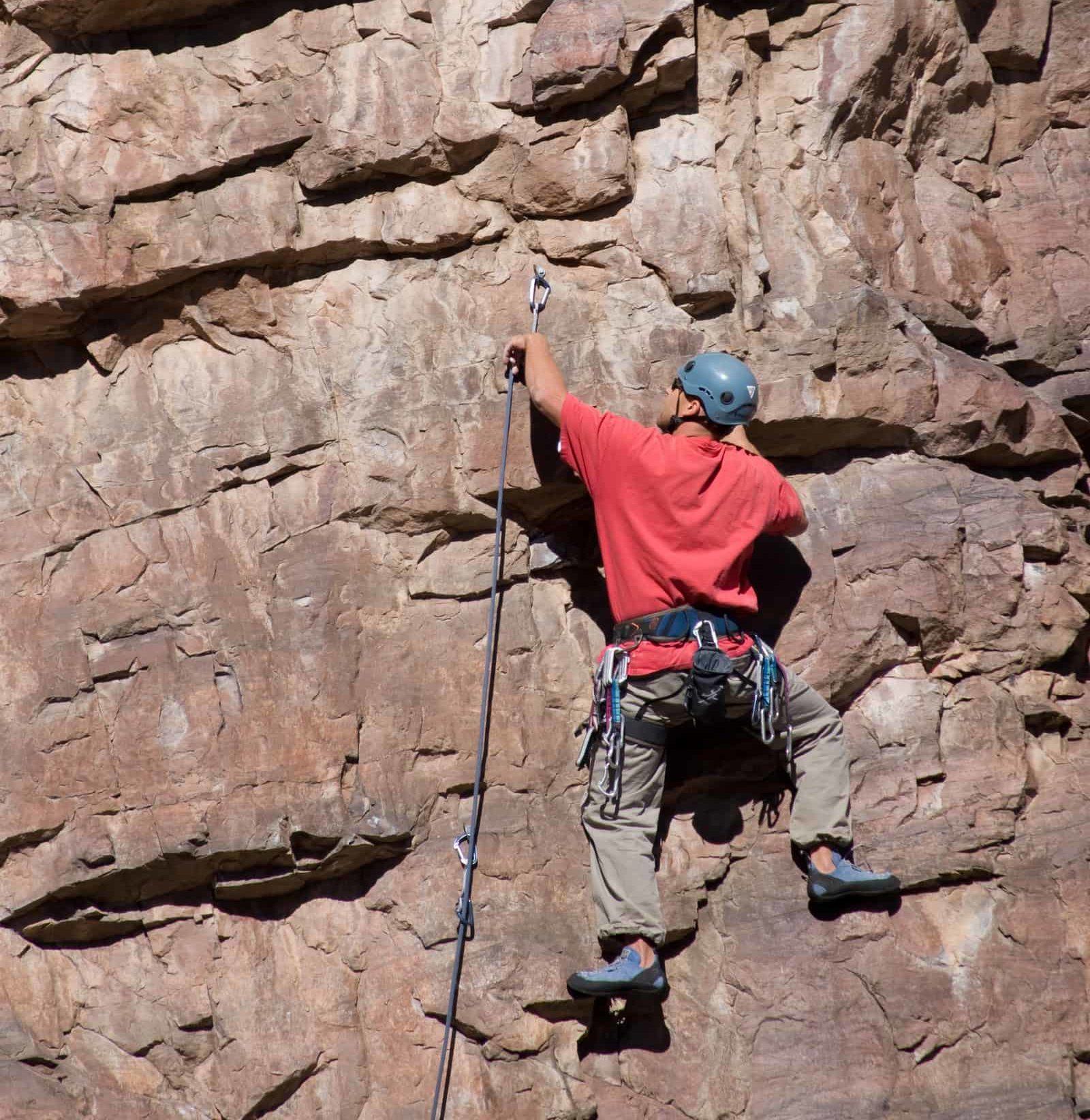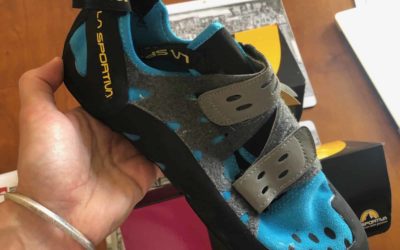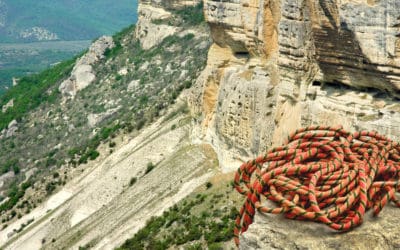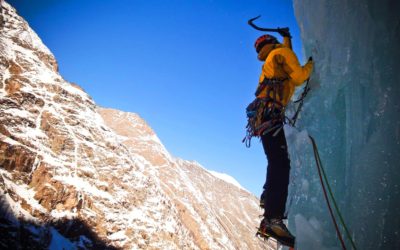
Very few rock climbers that I know of wear helmets, despite the fact that a bad fall, where you could bang you head against the rock face, could be fatal or leave you with a serious concussion.
Wearing a helmet protects your head against rocks, debris or equipment falling from above. It also mitigates injuries caused by hitting your head against a rock ceiling or against the rock face if you do fall. All of these are pretty good reasons for wearing a helmet.
That said, most rock climbers and belayers don’t wear helmets, especially when sports climbing. In traditional (trad) climbing and ice climbing, it’s more common to see people wearing helmets.
So, in short, even though head injuries in climbing are far less common than you’d see in other sports, like cycling, you should actually be wearing a helmet every time you hit the crag of climbing gym.
Now that you know that you should always be wearing a helmet, the question arises: Which helmet should I use? How do I choose a helmet? Let’s answer that one:
Choosing a Rock Climbing Helmet
Firstly, you need to know that there are three basic types of helmet: hard shell, foam and hybrid. The type you choose would depend on the environment you’ll be climbing in and the specific characteristics you need in a helmet. First, we’ll explore the attributes of each type.
Types of Helmet:
Hard Shell
Think construction site helmet. The hardshell helmet uses a hard outer shell with inner webbing to distribute and absorb the force of impact against your head in order to protect you and minimize any injury you might incur. These helmets are easy to resize and usually have the widest scope of sizes available in one helmet, which is awesome if multiple people are sharing the helmet. They’re also tough and durable, so you hard shell will probably have a very long lifespan.
In the downside, these are not well ventilated. They’re also heavy and clumsy, so not the best of you’re doing some intricate work in tight, hot spaces.
Foam
This one is similar to a bicycle helmet, consisting of foam, such as expanded polystyrene (EPS) cover in a thin layer of polycarbonate. The thick foam will protect your head by absorbing the force of a collision, while the polycarbonate will protect you from minor bumps.
This one is by far the most lightweight option, but it’s usually expensive and quite fragile.
Hybrid
The best of both worlds. Here, a mixture of foam and hard shell is used. The polycarbonate of traditional foam helmets is replaced with ABS (thermoplastic) that’s thicker and more durable.
With hybrid helmets, you get a lightweight helmet that’s durable and not as expensive as a foam helmet.

Proper Fit for a Mountaineering Helmet
Your helmet should fit just right. This means a snug fit that’s still comfortable. For proper protection, your forehead should be covered almost to your brow line and the helmet should buckle tightly but comfortably under your chin.
If your helmet fits well, you should be able to nod your head (like when saying yes) and shake your head (like when saying no) without it wiggling around, even before you fasten the chin strap. It should also not dig into your neck when you’re looking up, since this would hamper you when climbing.
If you’re planning on using your helmet for cold-weather climbing as well as in summer, make sure that it’s adjustable, since you’ll want to wear an insulating hat or cap underneath in winter.
Good quality climbing helmets have adjustable rotating dials on the sides, allowing you to adjust the straps exactly as you like them.
Safety
Any major impact will drastically shorter, or even end, the lifespan of your helmet. Each helmet has a safety rating, explaining how long your helmet is likely to last and what level of impact it is capable to withstand before you should replace it.
Since an impact compromises the effectiveness of a helmet, you should never buy a second-hand one, because you don’t know how many hits it’s taken. If you take that chance, you run the risk of the helmet not working when you need it most.
More Helmet Features
When choosing a helmet, think carefully of where and when you want to use it. Some helmets have headlamp clips, enabling you to use them more efficiently at night or in caves. You might want something with a bit more ventilation if you’re planning on climbing in desert areas or do some seriously hard-core, high energy climbing. If you’re planning on ice climbing or taking on dirty routes, consider choosing a helmet with a visor to protect your eyes against debris and other nasties.
Conclusion
I would always advise to use a helmet when rock climbing. As with anything in life, don’t be dissuaded and change your opinion because of how ‘’people’’ perceive it. Not wearing a helmet just to ‘’be cool’’ and fit in is just plain stupid if there is even a tiny chance to be fatally struck by a falling rock.
Finally, always make sure that your helmet fits properly and that you’re using it within the recommended safety rating. Happy adventures!
Written by Felix
April 17, 2019

About me
Hi! I’m Felix. When I’m not spending time out in the mountains, I like to write about my hobbies. That is how Mountain Homies was created. On this site, I try to gather all the juicy information about Mountaineering that I have learned since I started. Happy adventures!
Recent Posts
5 Ways of Knowing If Your Climbing Shoes Are Too Big
It has almost become a prestige among climbers to be able to boast about how small and tight climbing shoes can be used. There is therefore a lot of talk…
Mountain Climbing vs Rock Climbing: 5 Biggest Differences
The key differences between rock climbing and mountain climbing are the gear requirements, environmental risk, geographical locations, weather and…
Rock Climbing vs Ice Climbing: Everything You Need To Know
In summary, In Ice climbing you need more equipment and falling is more dangerous than in rock climbing. Routes on ice and rock have…
Related Articles
Mountain Climbing vs Rock Climbing: 5 Biggest Differences
The key differences between rock climbing and mountain climbing are the gear requirements, environmental risk, geographical locations, weather and…
Rock Climbing vs Ice Climbing: Everything You Need To Know
In summary, In Ice climbing you need more equipment and falling is more dangerous than in rock climbing. Routes on ice and rock have…
World’s 11 Highest Unclimbed Mountains
Unclimbed peaks are often referred to as Virgin peaks. Many of these peaks are considered to be tougher and more difficult than Everest. Furthermore, the mountains…
Stay Up to Date With The Latest News & Updates
Join Our Newsletter
The owner of this site is a participant in the Amazon Services LLC Associates Program, an affiliate advertising program designed to provide a means for sites to earn advertising fees by advertising and linking to amazon.com.





